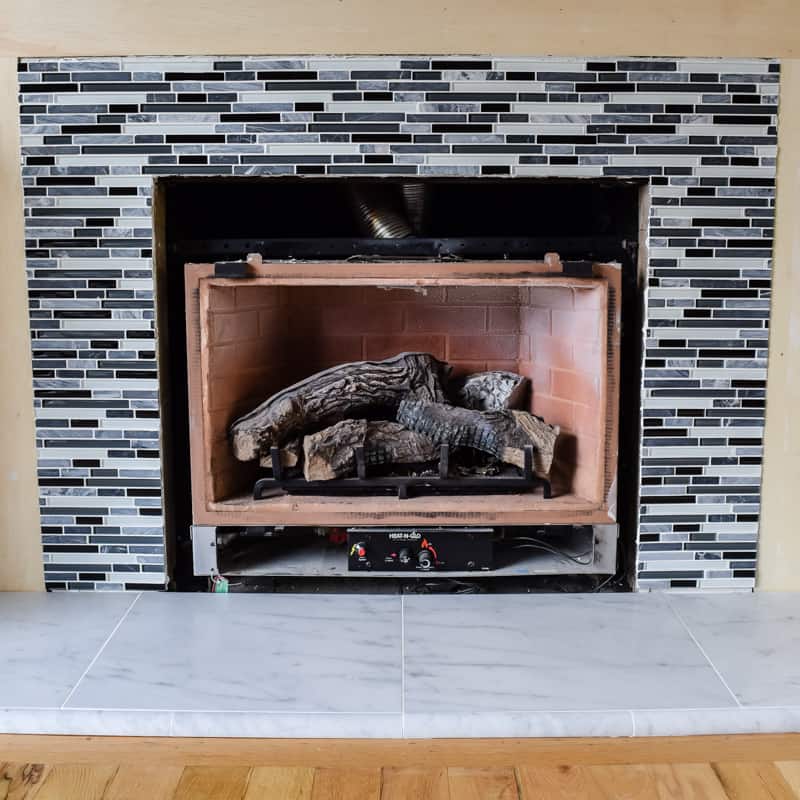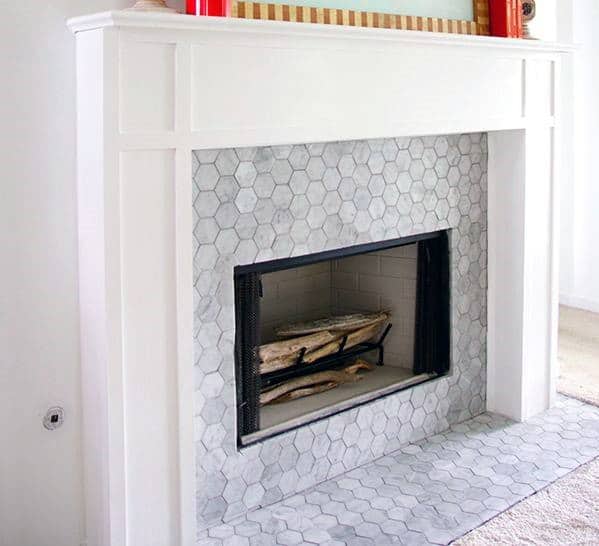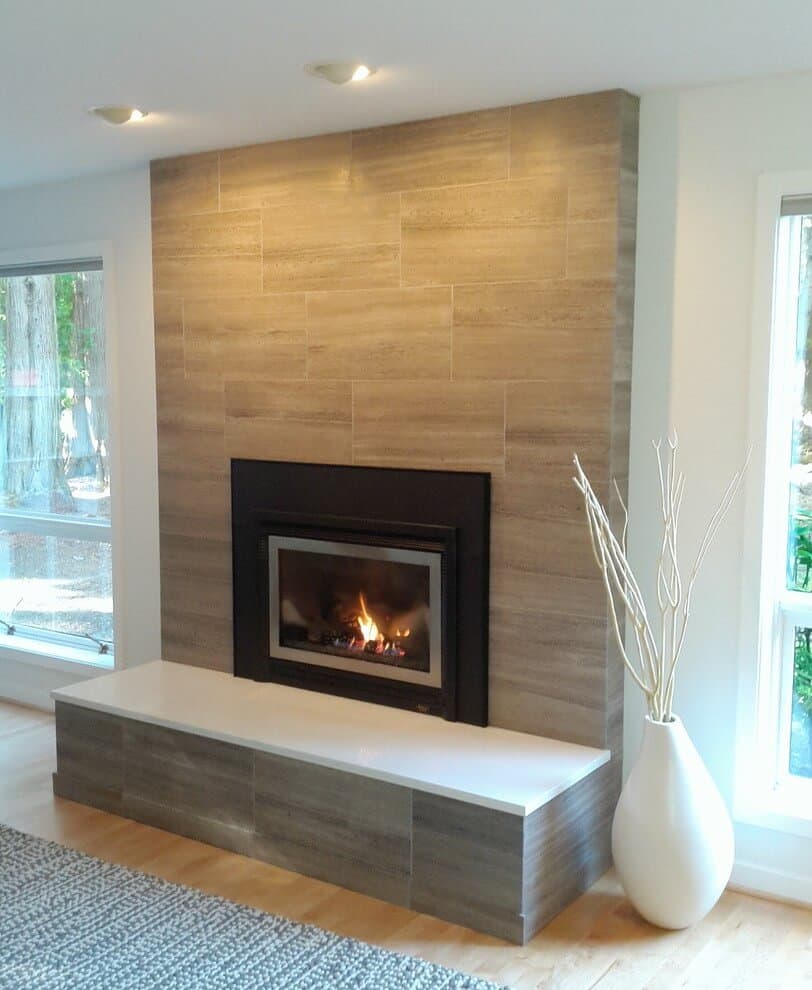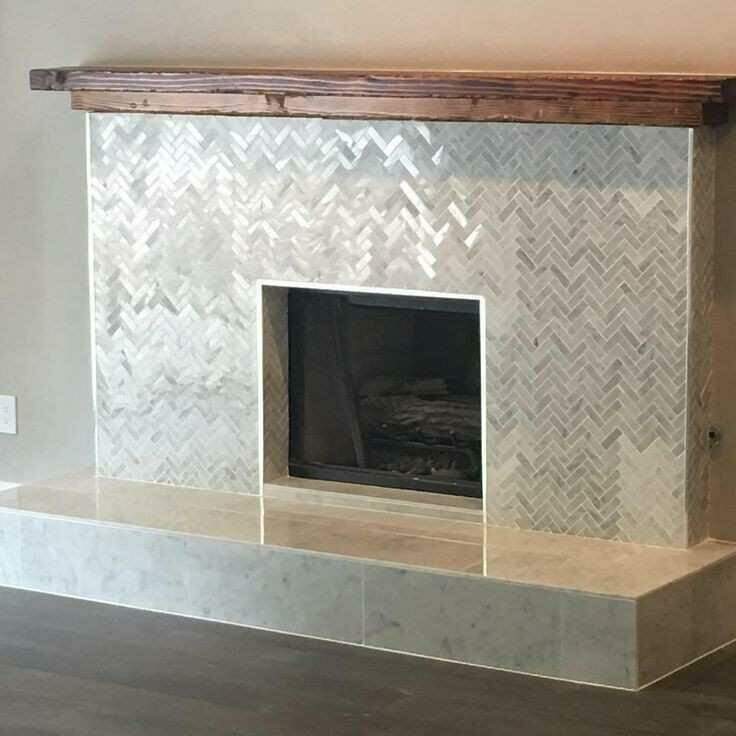Introduction to Small Fireplace Tiles
Small fireplace tiles are a versatile and attractive option for enhancing the appearance of a fireplace. These tiles, which typically measure between 1 and 4 inches, offer a range of design possibilities due to their size and variety of available materials, colors, and patterns. Using small tiles around a fireplace can create intricate designs and textures, making the fireplace a stunning focal point in any room.
The history of fireplace tiles dates back to ancient civilizations, where tiles were used not only for their practical benefits but also for their aesthetic appeal. Over the centuries, the use of tiles around fireplaces has evolved, with different cultures and periods influencing their design and application. Today, small fireplace tiles are appreciated for their ability to blend traditional craftsmanship with modern design trends.
One of the primary advantages of small fireplace tiles is their ability to create detailed and intricate patterns. Whether arranged in a simple grid or a more complex mosaic, these tiles can add depth and visual interest to a fireplace. Their small size allows for greater flexibility in design, enabling homeowners to achieve a customized look that reflects their style.

In addition to their aesthetic benefits, small fireplace tiles are also practical. They are durable, easy to clean, and resistant to heat, making them an ideal choice for the area surrounding a fireplace. The right selection of tiles can enhance the fireplace’s functionality while also ensuring it remains a beautiful feature of the home for years to come.
Small fireplace tiles come in a variety of materials, each offering distinct characteristics and benefits. Common materials include ceramic, porcelain, glass, and natural stone. Each material has its unique qualities, such as color, texture, and durability, allowing homeowners to choose the best option for their specific needs and preferences.
Overall, small fireplace tiles provide a perfect blend of beauty and practicality. By carefully selecting the right materials, colors, and patterns, homeowners can transform their fireplaces into stunning centerpieces that enhance the overall aesthetic of their living spaces.

Choosing the Right Material
Selecting the right material for small fireplace tiles is crucial to achieving both the desired aesthetic and functional qualities. The choice of material affects the tiles’ durability, heat resistance, maintenance requirements, and overall appearance. Common materials for small fireplace tiles include ceramic, porcelain, glass, and natural stone, each offering unique advantages.
Ceramic tiles are a popular choice for fireplace surrounds due to their versatility and affordability. Made from clay and fired at high temperatures, ceramic tiles are available in a wide range of colors, patterns, and finishes. They are relatively easy to install and maintain, making them an excellent option for homeowners looking for a cost-effective yet stylish solution. Ceramic tiles are also heat-resistant, ensuring they can withstand the temperatures around a fireplace.
Porcelain tiles, a type of ceramic tile, are known for their durability and low porosity. They are denser and more resistant to moisture and staining than regular ceramic tiles, making them an ideal choice for areas exposed to high heat and occasional soot. Porcelain tiles can mimic the appearance of natural stone or wood, offering a wide range of design possibilities. Their robustness and ease of maintenance make them a practical and long-lasting option for fireplace surrounds.

Glass tiles bring a unique and modern touch to fireplace designs. Their reflective surface can add brightness and depth to a space, creating a visually striking effect. Glass tiles are available in a variety of colors and finishes, including clear, frosted, and textured options. While glass tiles are heat-resistant and easy to clean, they can be more challenging to install and may require professional assistance to ensure a flawless finish. They are best suited for creating accent designs or borders around a fireplace.
Natural stone tiles, such as marble, granite, slate, and travertine, offer timeless beauty and exceptional durability. Each type of stone has its distinct characteristics, with variations in color, texture, and veining that add a unique touch to any fireplace surround. Natural stone tiles are highly heat-resistant and can withstand the demands of a working fireplace. However, they may require more maintenance than ceramic or porcelain tiles, including regular sealing to prevent staining and preserve their appearance.
Another option is metal tiles, which can add a contemporary and industrial look to a fireplace. Metals like stainless steel, copper, and aluminum can be used to create sleek, modern designs. Metal tiles are heat-resistant and durable, but they can be prone to scratching and may require special cleaning products to maintain their finish. They are often used as accents or to create a striking, modern focal point around the fireplace.
Ultimately, the choice of material for small fireplace tiles should consider factors such as aesthetic preferences, budget, maintenance requirements, and the specific demands of the fireplace area. By carefully evaluating these factors, homeowners can select the best material to achieve a beautiful and functional fireplace surround.

Design Possibilities
The use of small fireplace tiles opens up a world of design possibilities, allowing homeowners to create unique and personalized fireplace surrounds. From traditional patterns to modern mosaics, the versatility of small tiles enables intricate designs that can enhance the visual appeal of any living space.
One popular design approach is the use of geometric patterns. Small tiles can be arranged in various geometric shapes, such as squares, rectangles, diamonds, or hexagons, to create visually striking and orderly patterns. These geometric designs can add a sense of structure and balance to the fireplace surround, complementing a variety of interior styles, from contemporary to traditional.
Mosaic designs are another excellent option for small fireplace tiles. Mosaics involve arranging small tiles in complex patterns or images, often incorporating a variety of colors and materials. This technique allows for highly detailed and artistic designs, making the fireplace a true centerpiece of the room. Mosaics can range from simple, repeating patterns to intricate scenes or abstract designs, providing endless creative possibilities.

Herringbone and chevron patterns are also popular choices for small fireplace tiles. These designs involve arranging rectangular tiles at angles to create a zigzag effect. Herringbone patterns, where tiles are laid in a V-shaped pattern, and chevron patterns, which feature continuous zigzags, can add dynamic movement and visual interest to the fireplace surround. These patterns are versatile and can be adapted to both traditional and modern interiors.
Accent borders and trim are another way to utilize small fireplace tiles effectively. By incorporating contrasting colors, textures, or materials, accent borders can frame the fireplace and highlight its architectural features. These borders can be simple, with a single row of tiles, or more elaborate, with intricate designs that add depth and detail to the fireplace surround.
For those who prefer a more understated look, monochromatic or tone-on-tone designs can create a subtle yet elegant effect. Using tiles in varying shades of the same color or different textures within a single color palette can add depth and sophistication without overwhelming the space. This approach is ideal for creating a cohesive and harmonious look that blends seamlessly with the rest of the room’s decor.
Finally, mixing different materials can result in a unique and visually appealing fireplace surround. Combining ceramic tiles with natural stone, glass, or metal can create a rich, layered effect that adds texture and dimension. This approach allows homeowners to play with contrasts and harmonies, resulting in a truly one-of-a-kind fireplace design.

Interesting Articles You May Want to Check:
- Bicester Tiles And Fireplaces
- Marble Herringbone Tile Fireplace
- Mottled Fireplace Tiles
- How to Tile a Fireplace Surround
- Slate Tile Fireplace Surround

Installation Techniques
Installing small fireplace tiles requires careful planning and attention to detail to ensure a professional and durable finish. The process involves several key steps, from preparing the surface to selecting the right adhesive and grout. Understanding the proper installation techniques can help achieve a flawless and long-lasting fireplace surround.
The first step in the installation process is to prepare the surface. The area around the fireplace must be clean, dry, and free of any existing materials or debris. If the surface is uneven or damaged, it may need to be repaired or leveled before installation. In some cases, a backer board may be required to provide a stable and heat-resistant surface for the tiles.
Once the surface is prepared, the next step is to plan the layout of the tiles. This involves measuring the area and marking guidelines to ensure the tiles are aligned correctly. Planning the layout can help avoid awkward cuts and ensure a balanced and symmetrical design. It’s also important to consider the placement of any accent tiles or borders during this stage.
Selecting the right adhesive is crucial for securing the tiles to the surface. Heat-resistant tile adhesive is recommended for fireplace surrounds to ensure the tiles remain in place despite the high temperatures. The adhesive should be applied evenly using a notched trowel, creating a consistent layer that will hold the tiles securely. It’s important to work in small sections to prevent the adhesive from drying out before the tiles are placed.

Once the adhesive is applied, the tiles can be placed according to the planned layout. Each tile should be pressed firmly into the adhesive, with spacers used to maintain consistent gaps between the tiles. It’s essential to check the alignment and level of the tiles frequently to ensure a professional finish. If any adjustments are needed, they should be made before the adhesive sets.
After the tiles are set and the adhesive has cured, the next step is to apply grout. Grout not only fills the gaps between the tiles but also provides additional stability and a finished look. Heat-resistant grout is recommended for fireplace surrounds to ensure it withstands the temperatures around the fireplace. The grout should be applied using a rubber float, pressing it into the gaps and removing any excess. Once the grout has set, the surface can be wiped clean with a damp sponge.
The final step in the installation process is sealing the tiles and grout. Sealing helps protect the tiles from stains and moisture, ensuring they remain beautiful and durable over time. The type of sealer used will depend on the material of the tiles and grout. It’s important to follow the manufacturer’s instructions for application and curing times to achieve the best results.
By following these installation techniques, homeowners can achieve a professional and long-lasting finish for their small fireplace tiles. Proper planning, careful execution, and attention to detail are key to ensuring the tiles remain securely in place and continue to enhance the fireplace’s appearance for years to come.

Maintenance and Care
Maintaining and caring for small fireplace tiles is essential to preserving their beauty and functionality. Regular cleaning and proper maintenance can prevent damage and ensure the tiles remain a stunning feature of the fireplace. Understanding the specific care requirements for different tile materials is crucial to keeping them in top condition.
One of the primary aspects of tile maintenance is regular cleaning. For ceramic and porcelain tiles, a simple solution of warm water and mild detergent is usually sufficient to remove dirt and grime. These tiles are generally easy to clean and do not require special products. A soft cloth or sponge should be used to wipe down the tiles, avoiding abrasive cleaners or scrubbers that could damage the surface.
Glass tiles, while also easy to clean, require a bit more care to prevent scratches. A gentle glass cleaner or a solution of vinegar and water can be used to keep glass tiles looking their best. It’s important to use a non-abrasive cloth or sponge to avoid scratching the surface. Regular cleaning can help maintain the tiles’ reflective properties and keep them looking bright and clear.

Natural stone tiles, such as marble, granite, or slate, require more specialized care. These materials are porous and can be susceptible to staining if not properly sealed and maintained. A pH-neutral cleaner specifically designed for natural stone should be used to clean these tiles. Harsh chemicals and acidic cleaners, such as vinegar or lemon juice, should be avoided as they can damage the stone. Regular sealing is necessary to protect natural stone tiles from stains and moisture.
Grout, the material used to fill the gaps between tiles, also requires regular maintenance. Grout can become stained or discolored over time, especially in areas exposed to soot and smoke from the fireplace. Regular cleaning with a grout cleaner or a mixture of baking soda and water can help keep grout looking fresh. Sealing the grout periodically can also prevent stains and make cleaning easier.
In addition to regular cleaning, it’s important to inspect the tiles and grout periodically for any signs of damage. Cracked or loose tiles should be repaired or replaced promptly to prevent further damage. If the grout becomes cracked or begins to deteriorate, it should be re-applied to ensure the tiles remain securely in place.
Finally, taking preventive measures can help maintain the appearance and longevity of small fireplace tiles. Avoid placing heavy objects on the mantle or near the tiles that could cause them to crack or chip. Using a fireplace screen can help protect the tiles from direct exposure to heat and soot. By following these maintenance and care tips, homeowners can ensure their small fireplace tiles remain beautiful and functional for years to come.

Enhancing the Fireplace Area
Enhancing the area around the fireplace with small tiles can significantly elevate the overall aesthetic of the room. Thoughtful design and strategic placement of tiles can transform the fireplace into a captivating focal point that draws attention and adds character to the space. There are several ways to enhance the fireplace area using small tiles.
One effective approach is to create a feature wall around the fireplace. Extending the tiles beyond the immediate fireplace surround and onto the adjacent wall can create a dramatic and cohesive look. This technique can help integrate the fireplace into the room’s design, making it a more prominent and visually appealing feature. A feature wall can be achieved using a single type of tile or by mixing different materials and patterns for added interest.
Incorporating a hearth can also enhance the fireplace area. A hearth, which is the floor area in front of the fireplace, can be tiled to complement the surround and add a sense of continuity. Using small tiles on the hearth can create a seamless transition from the fireplace to the floor, enhancing the overall design. The hearth can also serve as a functional space for placing firewood or decorative items, further enhancing the fireplace’s visual appeal.
Adding a mantle and accent tiles can elevate the fireplace’s appearance. A well-designed mantle provides a platform for displaying decorative objects, artwork, or plants, adding layers of interest to the fireplace area. Incorporating accent tiles on the mantle or around the fireplace opening can create a focal point and highlight the architectural details. Accent tiles in contrasting colors or materials can add depth and dimension to the design.
Lighting plays a crucial role in enhancing the fireplace area. Installing wall sconces or recessed lighting around the fireplace can highlight the tiles’ texture and pattern, creating a warm and inviting ambiance. Under-mantle lighting can also be used to illuminate the hearth and surrounding tiles, adding a cozy glow to the space. Proper lighting can emphasize the fireplace’s design and make it a more prominent feature in the room.
Decorative elements and accessories can further enhance the fireplace area. Consider adding a decorative screen or fire tools that complement the style of the tiles. A well-chosen rug or set of fireplace accessories can add a touch of elegance and cohesiveness to the design. Seasonal decorations, such as garlands, candles, or artwork, can also add a dynamic and ever-changing element to the fireplace area.
Finally, integrating the fireplace design with the room’s overall decor can create a harmonious and balanced look. Coordinating the tile colors and patterns with the room’s color scheme and furnishings can create a cohesive and unified design. Thoughtful placement of furniture, such as seating arrangements that face the fireplace, can make the fireplace the focal point of the room, enhancing its visual impact.

Common Mistakes to Avoid
When using small fireplace tiles, it’s essential to avoid common mistakes that can compromise the design and functionality of the fireplace surround. Being aware of these pitfalls can help ensure a successful and long-lasting installation.
One common mistake is selecting tiles that are not heat-resistant. Not all tiles are suitable for use around a fireplace, as they may crack or become damaged when exposed to high temperatures. It’s crucial to choose tiles specifically designed for use in high-heat areas to ensure they can withstand the conditions around the fireplace.
Improper surface preparation is another frequent issue. The surface where the tiles will be installed must be clean, dry, and free of any debris or existing materials. Failing to properly prepare the surface can result in poor adhesion and tiles that do not stay in place. Taking the time to ensure the surface is adequately prepared is essential for a successful installation.
Using the wrong adhesive can also lead to problems. Standard tile adhesive may not be suitable for the high temperatures around a fireplace. It’s important to use a heat-resistant adhesive that is specifically formulated for use in areas exposed to heat. This will help ensure the tiles remain securely in place and do not become damaged over time.
Neglecting to plan the tile layout in advance can result in a disorganized and unbalanced design. Taking the time to measure the area and plan the placement of the tiles can help avoid awkward cuts and ensure a symmetrical and visually appealing layout. Proper planning is especially important when incorporating accent tiles or intricate patterns.
Applying grout improperly can lead to a subpar finish. Using the wrong type of grout or failing to apply it correctly can result in gaps, uneven surfaces, or grout that cracks and deteriorates over time. It’s important to use a heat-resistant grout and to follow proper application techniques to achieve a smooth and durable finish.
Finally, neglecting regular maintenance can affect the appearance and longevity of the tiles. Failing to clean the tiles and grout regularly can lead to the buildup of dirt, soot, and stains. Regular cleaning and sealing, especially for natural stone tiles, are essential to preserving the tiles’ beauty and functionality.

What materials are best for small fireplace tiles?
Small fireplace tiles can be made from various materials, each offering unique benefits. Ceramic and porcelain tiles are popular for their durability, heat resistance, and wide range of colors and patterns. Glass tiles add a modern touch and reflective quality, while natural stone tiles, such as marble, granite, and slate, offer timeless beauty and exceptional durability. The choice of material depends on personal preferences, budget, and the desired aesthetic.
How do I clean and maintain small fireplace tiles?
Cleaning and maintaining small fireplace tiles involve regular dusting and wiping with a mild detergent solution. Ceramic and porcelain tiles are easy to clean with warm water and a soft cloth, while glass tiles require a gentle glass cleaner to prevent scratches. Natural stone tiles need a pH-neutral cleaner and regular sealing to protect against stains and moisture. Regular inspection and maintenance can prevent damage and keep the tiles looking their best.
Can small fireplace tiles be used in a modern interior?
Yes, small fireplace tiles can be used in modern interiors to create sleek and contemporary designs. Glass tiles, in particular, add a modern touch with their reflective surface and vibrant colors. Porcelain tiles that mimic natural materials, such as wood or concrete, can also complement modern decor. The versatility of small tiles allows for various design possibilities, including geometric patterns and minimalist arrangements, making them suitable for modern interiors.
How do I choose the right grout color for small fireplace tiles?
Choosing the right grout color depends on the desired look and the color of the tiles. For a seamless and cohesive appearance, matching the grout color to the tile color can create a unified look. Contrasting grout colors can highlight the individual tiles and create a more defined pattern. Neutral grout colors, such as white, gray, or beige, are versatile and can work well with most tile colors. It’s important to consider the overall design and the effect the grout color will have on the final appearance.
Is professional installation necessary for small fireplace tiles?
While DIY installation of small fireplace tiles is possible, professional installation is recommended for the best results. Professional installers have the experience and tools necessary to ensure the tiles are properly aligned, securely attached, and finished with a high-quality look. They can also handle complex designs and patterns that may be challenging for a DIY project. Hiring a professional can ensure a durable and visually appealing fireplace surround.
How can I enhance the design of my fireplace with small tiles?
Enhancing the design of a fireplace with small tiles can be achieved through various techniques. Creating a feature wall by extending the tiles beyond the fireplace surround can make a dramatic statement. Incorporating a hearth, accent borders, or trim can add depth and detail. Using lighting to highlight the tiles’ texture and pattern can create a warm ambiance. Mixing different materials and patterns can add visual interest and create a unique and personalized look.

Related Posts: